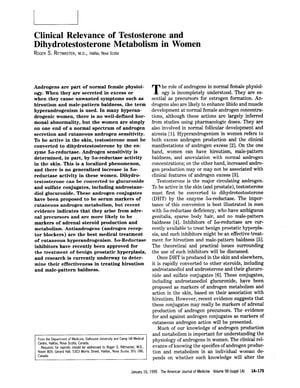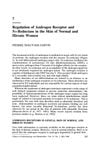Clinical Relevance of Testosterone and Dihydrotestosterone Metabolism in Women
January 1995
in “
The American journal of medicine
”
testosterone dihydrotestosterone DHT hyperandrogenism hirsutism male-pattern baldness androgens 5α-reductase androstanediol glucuronide adrenal steroid antiandrogens 5α-reductase inhibitors benign prostatic hyperplasia testosterone DHT male-pattern baldness androgens 5-alpha-reductase antiandrogens 5-alpha-reductase inhibitors BPH

TLDR Testosterone and dihydrotestosterone play a role in women's health issues like excess hair and baldness, and treatments blocking these hormones may help.
The document from 1995 discusses the role of androgens in female physiology, particularly in conditions of hyperandrogenism, which can lead to symptoms like hirsutism and male-pattern baldness. It explains that in many cases of hyperandrogenism in women, there is no distinct hormonal abnormality; rather, these women may represent the higher end of a normal range of androgen secretion and skin sensitivity to androgens. The activity of the enzyme 5α-reductase, which converts testosterone to dihydrotestosterone (DHT) in the skin, is a key factor in androgen sensitivity, but this activity is localized and not generally increased in hyperandrogenic women. The document also notes that while androgen conjugates such as androstanediol glucuronide were once thought to be markers of cutaneous androgen metabolism, they are more likely indicators of adrenal steroid production. The best medical treatments for cutaneous hyperandrogenism are antiandrogens, and 5α-reductase inhibitors, which have been approved for treating benign prostatic hyperplasia, are being researched for their potential effectiveness in treating hirsutism and male-pattern baldness in women.


